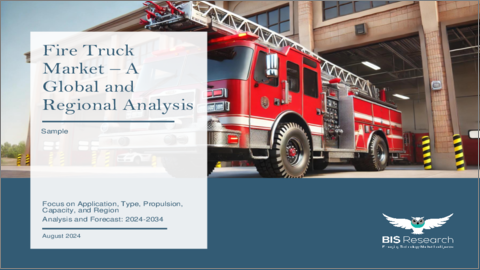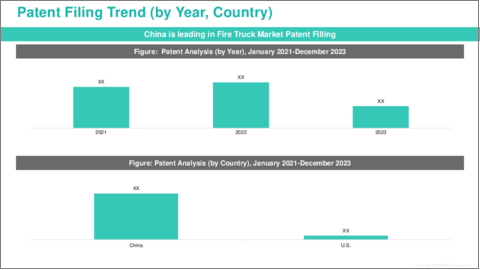|
|
市場調査レポート
商品コード
1539262
消防車市場- 世界および地域別分析:用途別、タイプ別、推進力別、積載量別、地域別 - 分析と予測(2024年~2034年)Fire Truck Market - A Global and Regional Analysis: Focus on Application, Type, Propulsion, Capacity, and Region - Analysis and Forecast, 2024-2034 |
||||||
カスタマイズ可能
|
|||||||
| 消防車市場- 世界および地域別分析:用途別、タイプ別、推進力別、積載量別、地域別 - 分析と予測(2024年~2034年) |
|
出版日: 2024年08月23日
発行: BIS Research
ページ情報: 英文 120 Pages
納期: 1~5営業日
|
全表示
- 概要
- 目次
消防車市場は、様々な市場促進要因に後押しされ、大きな成長を遂げています。
楽観的シナリオでは、消防車の市場規模は、2024年に85億9,000万米ドルになるとみられ、CAGR 3.02%で拡大し、2034年には115億7,000万米ドルに達すると予測されています。
消防車市場の成長は、主に世界中で都市化と工業化が進んでいることが要因となっています。都市部が拡大し、産業活動が急増するにつれて、高度な消防ソリューションへの需要が高まっています。都市は著しい人口増加を経験しており、高層ビル、集合住宅、商業施設の建設につながっています。これらの構造物には強固な火災安全機構が必要であり、空中はしご、水槽、高度なポンプシステムなどの高度な技術を備えた最新の消防車の購入が必要となります。さらに、商業および産業環境における火災安全性に関連する厳しい政府規制および基準により、自治体および民間団体は、コンプライアンスを確保し、人命と財産を守るために最新式の消防車に投資することを余儀なくされています。
| 主要市場統計 | |
|---|---|
| 予測期間 | 2024年~2034年 |
| 2024年の評価 | 85億9,000万米ドル |
| 2034年の予測 | 115億7,000万米ドル |
| CAGR | 3.02% |
もう一つの重要な成長要因は、山火事や自然災害の発生率の上昇であり、これによって特殊な消防設備の必要性が浮き彫りになっています。気候変動により、特に北米やオーストラリアなどの地域では山火事の頻度と強度が増加しています。このため、政府機関や消防署は、険しい地形用に設計され、大容量の送水ポンプや泡沫システムなどの機能を備えた消防車を調達し、消火能力を強化する必要に迫られています。さらに、モノのインターネット(IoT)やテレマティクスの消防車への統合といった技術の進歩により、消防車の運用効率と応答時間が向上しています。これらの技術革新は、消火活動中のリアルタイムの監視と調整を可能にし、最新の消防車の採用をさらに促進しています。都市開拓、規制要件、自然災害に対処する差し迫った必要性の組み合わせは、消防車市場の持続的成長に大きく寄与しています。
北米の消防車市場は、山火事の頻度の増加、厳しい火災安全規制、緊急対応インフラへの多額の投資など、特定の地域的要因の組み合わせによって成長しています。近年、北米、特に米国とカナダでは、気候変動と長引く干ばつ状態によって悪化した壊滅的な山火事が急増しています。このような火災のため、困難な地形を走破し、大規模な火災に効果的に対処できる特殊な消防車の調達が必要となっています。さらに、北米の消防署は、全米防火協会(NFPA)などの組織が定めた厳格な安全基準や規制の対象であり、消防設備の定期的な更新や強化が義務付けられています。さらに、緊急対応車両のアップグレードを目的とした政府からの多額の資金援助や補助金が、市場を強化しています。大都市における都市化と人口増加も需要に寄与しており、自治体は人口密集地や高価値のインフラを保護するため、最新技術を駆使した消防車に投資しています。こうした地域特有の力学が、北米の消防車市場の堅調な成長を後押ししています。
当レポートでは、世界の消防車市場について調査し、市場の概要とともに、用途別、タイプ別、推進力別、積載量別、地域別の動向、および市場に参入する企業のプロファイルなどを提供しています。
目次
エグゼクティブサマリー
第1章 市場:業界の展望
- 動向:現在および将来の影響評価
- サプライチェーンの概要
- R&Dレビュー
- 規制状況
- ステークホルダー分析
- 主要な世界的イベントの影響分析
- 市場力学の概要
第2章 消防車市場(用途別)
- 用途のセグメンテーション
- 用途の概要
- 消防車市場(用途別)
第3章 消防車市場(製品別)
- 製品セグメンテーション
- 製品概要
- 消防車市場(タイプ別)
- 消防車市場(推進力別)
- 消防車市場(積載量別)
第4章 消防車市場(地域別)
- 消防車市場- 地域別
- 北米
- 欧州
- アジア太平洋
- その他の地域
第5章 企業プロファイル
- 今後の見通し
- 地理的評価
- Rosenbauer International AG
- IVECO Group
- OSHKOSH Corporation
- Morita Holdings Corporation
- REV Group
- NAFFCO
- Simon Carmichael International Group Limited
- ZIEGLER
- Desautel Fire Trucks
- Volkan
- Euro GV
- W.S. Darley
- Angloco Limited
- Palmer Asia
- SVI Trucks
第6章 調査手法
Introduction to the Fire Trucks Market
The fire trucks market is undergoing significant growth, propelled by various key factors and market drivers. In an optimistic scenario, the market is evaluated at a valuation of $8.59 billion in 2024 and is projected to expand at a CAGR of 3.02% to reach $11.57 billion by 2034.
The growth of the fire truck market is primarily driven by increasing urbanization and industrialization across the globe. As urban areas expand and industrial activities surge, the demand for advanced firefighting solutions escalates. Cities are experiencing significant population growth, which leads to the construction of high-rise buildings, residential complexes, and commercial establishments. These structures require robust fire safety mechanisms, necessitating the acquisition of modern fire trucks equipped with sophisticated technologies such as aerial ladders, water tanks, and advanced pumping systems. Additionally, stringent government regulations and standards related to fire safety in commercial and industrial settings compel municipalities and private entities to invest in state-of-the-art fire trucks to ensure compliance and safeguard human lives and property.
| KEY MARKET STATISTICS | |
|---|---|
| Forecast Period | 2024 - 2034 |
| 2024 Evaluation | $8.59 Billion |
| 2034 Forecast | $11.57 Billion |
| CAGR | 3.02% |
Another critical growth driver is the rising incidence of wildfires and natural disasters, which has highlighted the need for specialized firefighting equipment. Climate change has led to an increase in the frequency and intensity of wildfires, particularly in regions like North America and Australia. This has prompted government agencies and fire departments to bolster their firefighting capabilities by procuring fire trucks designed for rugged terrains and equipped with features such as high-capacity water pumps and foam systems. Moreover, advancements in technology, such as the integration of the Internet of Things (IoT) and telematics in fire trucks, enhance their operational efficiency and response time. These innovations enable real-time monitoring and coordination during firefighting operations, further driving the adoption of modern fire trucks. The combination of urban development, regulatory requirements, and the pressing need to address natural calamities significantly contributes to the sustained growth of the fire truck market.
The fire truck market in North America is growing due to a combination of specific regional factors, including the increasing frequency of wildfires, stringent fire safety regulations, and significant investments in emergency response infrastructure. In recent years, North America, particularly the U.S. and Canada, has witnessed a surge in devastating wildfires, exacerbated by climate change and prolonged drought conditions. These fires have necessitated the procurement of specialized fire trucks capable of navigating difficult terrains and effectively combating large-scale blazes. Furthermore, North American fire departments are subject to rigorous safety standards and regulations set by organizations such as the National Fire Protection Association (NFPA), which mandate regular updates and enhancements to firefighting equipment. In addition, substantial government funding and grants aimed at upgrading emergency response fleets have bolstered the market. Urbanization and population growth in major cities also contribute to the demand, as municipalities invest in modern, technologically advanced fire trucks to protect densely populated areas and high-value infrastructure. These region-specific dynamics drive the robust growth of the fire truck market in North America.
Market Segmentation:
Segmentation 1: by Application
- Municipal
- Military
- Airport and Industrial
Segmentation 2: by Type
- Pumper Trucks
- Aerial Trucks
- Tender Trucks
- Air Rescue and Firefighting (ARFF) Trucks
- Hazmat Trucks
Segmentation 3: by Propulsion
- Internal Combustion Engine (ICE)
- Electric Vehicle (EV)
Segmentation 4: by Capacity
- <500 Gallons
- 501-1000 Gallons
- 1001-2000 Gallons
- >2000 Gallons
Segmentation 5: by Region
- North America
- Europe
- Asia-Pacific
- Rest-of-the-World
How can this report add value to an organization?
Product/Innovation Strategy: This report provides a comprehensive product/innovation strategy for the global fire truck market, identifying opportunities for market entry, technology adoption, and sustainable growth. It offers actionable insights, helping organizations gain a competitive edge, and capitalize on the increasing demand.
Growth/Marketing Strategy: This report offers a comprehensive growth and marketing strategy designed specifically for the fire truck market. It presents a targeted approach to identifying specialized market segments, establishing a competitive advantage, and implementing creative marketing initiatives aimed at optimizing market share and financial performance. By harnessing these strategic recommendations, organizations can elevate their market presence, seize emerging prospects, and efficiently propel revenue expansion.
Competitive Strategy: This report crafts a strong competitive strategy tailored to the fire truck market. It evaluates market rivals, suggests methods to stand out, and offers guidance for maintaining a competitive edge. By adhering to these strategic directives, companies can position themselves effectively in the face of market competition, ensuring sustained prosperity and profitability.
Key Market Players and Competition Synopsis
The companies that are profiled have been selected based on thorough secondary research, which includes analyzing company coverage, product portfolio, market penetration, and insights gathered from primary experts.
Some of the prominent companies in this market are:
- Rosenbauer International AG
- IVECO Group
- OSHKOSH Corporation
- Morita Holdings Corporation
- REV Group
- NAFFCO
- ZIEGLER
Table of Contents
Executive Summary
Scope and Definition
Market/Product Definition
Key Questions Answered
Analysis and Forecast Note
1. Markets: Industry Outlook
- 1.1 Trends: Current and Future Impact Assessment
- 1.1.1 Rising Number of Fire Incidents, Accidents in The Manufacturing Industries, And Disasters.
- 1.1.2 Growing Adoption of Global Safety Standards Promoting Sophisticated Firefighting Vehicles
- 1.2 Supply Chain Overview
- 1.2.1 Value Chain Analysis
- 1.2.2 Pricing Forecast
- 1.3 R&D Review
- 1.3.1 Patent Filing Trend by Country, by Company
- 1.4 Regulatory Landscape
- 1.5 Stakeholder Analysis
- 1.5.1 Use Case
- 1.5.2 End User and Buying Criteria
- 1.6 Impact Analysis for Key Global Events
- 1.7 Market Dynamics Overview
- 1.7.1 Market Drivers
- 1.7.2 Market Restraints
- 1.7.3 Market Opportunities
2. Fire Truck Market (by Application)
- 2.1 Application Segmentation
- 2.2 Application Summary
- 2.3 Fire Truck Market (by Application)
- 2.3.1 Municipal
- 2.3.2 Military
- 2.3.3 Airport & Industrial
3. Fire Truck Market (by Products)
- 3.1 Product Segmentation
- 3.2 Product Summary
- 3.3 Fire Truck Market (by Type)
- 3.3.1 Pumper Trucks
- 3.3.2 Aerial Trucks
- 3.3.3 Tender Trucks
- 3.3.4 Air Rescue and Firefighting (ARFF) Trucks
- 3.3.5 Hazmat Trucks
- 3.4 Fire Truck Market (by Propulsion)
- 3.4.1 Internal Combustion Engine (ICE)
- 3.4.2 Electric Vehicle (EV)
- 3.5 Fire Truck Market (by Capacity)
- 3.5.1 <500 Gallons
- 3.5.2 501-1000 Gallons
- 3.5.3 1001-2000 Gallons
- 3.5.4 >2000 Gallons
4. Fire Truck Market (by Region)
- 4.1 Fire Truck Market - by Region
- 4.2 North America
- 4.2.1 Regional Overview
- 4.2.2 Driving Factors for Market Growth
- 4.2.3 Factors Challenging the Market
- 4.2.4 Application
- 4.2.5 Product
- 4.2.6 U.S.
- 4.2.6.1 Market by Application
- 4.2.6.2 Market by Product
- 4.2.7 Canada
- 4.2.7.1 Market by Application
- 4.2.7.2 Market by Product
- 4.2.8 Mexico
- 4.2.8.1 Market by Application
- 4.2.8.2 Market by Product
- 4.3 Europe
- 4.3.1 Regional Overview
- 4.3.2 Driving Factors for Market Growth
- 4.3.3 Factors Challenging the Market
- 4.3.4 Application
- 4.3.5 Product
- 4.3.6 Germany
- 4.3.6.1 Market by Application
- 4.3.6.2 Market by Product
- 4.3.7 France
- 4.3.7.1 Market by Application
- 4.3.7.2 Market by Product
- 4.3.8 U.K.
- 4.3.8.1 Market by Application
- 4.3.8.2 Market by Product
- 4.3.9 Italy
- 4.3.9.1 Market by Application
- 4.3.9.2 Market by Product
- 4.3.10 Spain
- 4.3.10.1 Market by Application
- 4.3.10.2 Market by Product
- 4.3.11 Rest-of-Europe
- 4.3.11.1 Market by Application
- 4.3.11.2 Market by Product
- 4.4 Asia-Pacific
- 4.4.1 Regional Overview
- 4.4.2 Driving Factors for Market Growth
- 4.4.3 Factors Challenging the Market
- 4.4.4 Application
- 4.4.5 Product
- 4.4.6 China
- 4.4.6.1 Market by Application
- 4.4.6.2 Market by Product
- 4.4.7 Japan
- 4.4.7.1 Market by Application
- 4.4.7.2 Market by Product
- 4.4.8 India
- 4.4.8.1 Market by Application
- 4.4.8.2 Market by Product
- 4.4.9 South Korea
- 4.4.9.1 Market by Application
- 4.4.9.2 Market by Product
- 4.4.10 Rest-of-Asia-Pacific
- 4.4.10.1 Market by Application
- 4.4.10.2 Market by Product
- 4.5 Rest-of-the-World
- 4.5.1 Regional Overview
- 4.5.2 Driving Factors for Market Growth
- 4.5.3 Factors Challenging the Market
- 4.5.4 Application
- 4.5.5 Product
- 4.5.6 South America
- 4.5.6.1 Market by Application
- 4.5.6.2 Market by Product
- 4.5.7 Middle East and Africa
- 4.5.7.1 Market by Application
- 4.5.7.2 Market by Product
5. Companies Profiled
- 5.1 Next Frontiers
- 5.2 Geographic Assessment
- 5.2.1 Rosenbauer International AG
- 5.2.1.1 Overview
- 5.2.1.2 Top Products/Product Portfolio
- 5.2.1.3 Top Competitors
- 5.2.1.4 Target Customers
- 5.2.1.5 Key Personnel
- 5.2.1.6 Analyst View
- 5.2.1.7 Market Share
- 5.2.2 IVECO Group
- 5.2.2.1 Overview
- 5.2.2.2 Top Products/Product Portfolio
- 5.2.2.3 Top Competitors
- 5.2.2.4 Target Customers
- 5.2.2.5 Key Personnel
- 5.2.2.6 Analyst View
- 5.2.2.7 Market Share
- 5.2.3 OSHKOSH Corporation
- 5.2.3.1 Overview
- 5.2.3.2 Top Products/Product Portfolio
- 5.2.3.3 Top Competitors
- 5.2.3.4 Target Customers
- 5.2.3.5 Key Personnel
- 5.2.3.6 Analyst View
- 5.2.3.7 Market Share
- 5.2.4 Morita Holdings Corporation
- 5.2.4.1 Overview
- 5.2.4.2 Top Products/Product Portfolio
- 5.2.4.3 Top Competitors
- 5.2.4.4 Target Customers
- 5.2.4.5 Key Personnel
- 5.2.4.6 Analyst View
- 5.2.4.7 Market Share
- 5.2.5 REV Group
- 5.2.5.1 Overview
- 5.2.5.2 Top Products/Product Portfolio
- 5.2.5.3 Top Competitors
- 5.2.5.4 Target Customers
- 5.2.5.5 Key Personnel
- 5.2.5.6 Analyst View
- 5.2.5.7 Market Share
- 5.2.6 NAFFCO
- 5.2.6.1 Overview
- 5.2.6.2 Top Products/Product Portfolio
- 5.2.6.3 Top Competitors
- 5.2.6.4 Target Customers
- 5.2.6.5 Key Personnel
- 5.2.6.6 Analyst View
- 5.2.6.7 Market Share
- 5.2.7 Simon Carmichael International Group Limited
- 5.2.7.1 Overview
- 5.2.7.2 Top Products/Product Portfolio
- 5.2.7.3 Top Competitors
- 5.2.7.4 Target Customers
- 5.2.7.5 Key Personnel
- 5.2.7.6 Analyst View
- 5.2.7.7 Market Share
- 5.2.8 ZIEGLER
- 5.2.8.1 Overview
- 5.2.8.2 Top Products/Product Portfolio
- 5.2.8.3 Top Competitors
- 5.2.8.4 Target Customers
- 5.2.8.5 Key Personnel
- 5.2.8.6 Analyst View
- 5.2.8.7 Market Share
- 5.2.9 Desautel Fire Trucks
- 5.2.9.1 Overview
- 5.2.9.2 Top Products/Product Portfolio
- 5.2.9.3 Top Competitors
- 5.2.9.4 Target Customers
- 5.2.9.5 Key Personnel
- 5.2.9.6 Analyst View
- 5.2.9.7 Market Share
- 5.2.10 Volkan
- 5.2.10.1 Overview
- 5.2.10.2 Top Products/Product Portfolio
- 5.2.10.3 Top Competitors
- 5.2.10.4 Target Customers
- 5.2.10.5 Key Personnel
- 5.2.10.6 Analyst View
- 5.2.10.7 Market Share
- 5.2.11 Euro GV
- 5.2.11.1 Overview
- 5.2.11.2 Top Products/Product Portfolio
- 5.2.11.3 Top Competitors
- 5.2.11.4 Target Customers
- 5.2.11.5 Key Personnel
- 5.2.11.6 Analyst View
- 5.2.11.7 Market Share
- 5.2.12 W.S. Darley
- 5.2.12.1 Overview
- 5.2.12.2 Top Products/Product Portfolio
- 5.2.12.3 Top Competitors
- 5.2.12.4 Target Customers
- 5.2.12.5 Key Personnel
- 5.2.12.6 Analyst View
- 5.2.12.7 Market Share
- 5.2.13 Angloco Limited
- 5.2.13.1 Overview
- 5.2.13.2 Top Products/Product Portfolio
- 5.2.13.3 Top Competitors
- 5.2.13.4 Target Customers
- 5.2.13.5 Key Personnel
- 5.2.13.6 Analyst View
- 5.2.13.7 Market Share
- 5.2.14 Palmer Asia
- 5.2.14.1 Overview
- 5.2.14.2 Top Products/Product Portfolio
- 5.2.14.3 Top Competitors
- 5.2.14.4 Target Customers
- 5.2.14.5 Key Personnel
- 5.2.14.6 Analyst View
- 5.2.14.7 Market Share
- 5.2.15 SVI Trucks
- 5.2.15.1 Overview
- 5.2.15.2 Top Products/Product Portfolio
- 5.2.15.3 Top Competitors
- 5.2.15.4 Target Customers
- 5.2.15.5 Key Personnel
- 5.2.15.6 Analyst View
- 5.2.15.7 Market Share
- 5.2.1 Rosenbauer International AG






